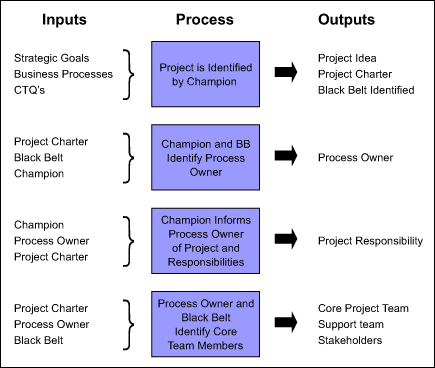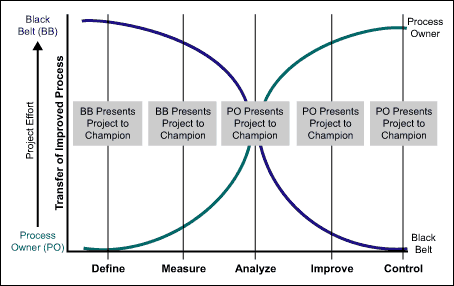
Process owners are a vital part of successful DMAIC (Define, Measure, Analyze, Improve, Control) and DFSS (Design for Six Sigma) projects. Process owners are responsible for the management of processes within the organization. In some cases process owners are current leaders/managers, and in other cases process owners may be taken from non-leadership positions. They are the people who receive the solutions created by an improvement team, and end up being responsible for managing the improved process. A process owner should be:
- A subject matter expert of the process.
- Someone who feels the pain of the poorly functioning process, and will experience the gain of the improved process.
- A person who can positively influence the improvement team members.
- Someone who is able to communicate effectively with the current or subsequent leaders of the process and who either have an effect on the process or are a recipient (customer) of the process.
- A person who has the aptitude for process thinking and improvement.
In addition, the process owner is responsible for acquiring key performance measures for the process, and they must make sure that the process is continually monitored, studied and improved even after the Six Sigma improvements have been implemented.
Wrong Way to Work with Process Owners
In many instances, sponsors or Champions present project leaders – Black Belts or Green Belts – with a difficult business problem to solve and then tell them to see that it gets done. The project leader begins by gathering the initial data and assessing the “as is” process. During this period, the potential process owner and team members are identified. Then, after the project charter is drafted and presented to the sponsor or Champion for approval, the project leader – a Black Belt in this case – starts by informing the process owner what is to be done and who the team members will be.
This approach puts a process owner on the defensive from the start, and will surely affect their participation. The process owner may feel as if the project is being forced on them, that they have no say in it. Throughout the project, the Black Belt will try to work with the process owner and team members, but so often it seems that the process owner is too busy to attend meetings, sends a replacement, or just waits until the project is done and then implements only what they think is necessary. In many cases, because the process owner was not involved from the beginning as they should have been, the improved process reverts back to the old process and defects reappear.
Right Way to Work with Process Owners
A sure way to get the buy-in and involvement from a process owner is to have them be a part of the decision-making process from the start (Figure 1). As soon as the project leader is informed by the sponsor or Champion of the process-related issue to be solved, they should decide together who the process owner will be. In organizations that already practice process management, this should be an easy task. Then the sponsor or Champion – not the Black Belt – should inform the designated process owner of their role and what their responsibilities are.

In addition, it must be made clear to the process owner that the ultimate success or failure of the project is a shared responsibility between them and the Black Belt. This “official notification” from the sponsor or Champion will have a greater impact on the process owner, than if the Black Belt project leader tells them they have been selected to be the process owner for this project.
Selecting Project Team Members
The next step is identifying potential team members. This should be done jointly by the project leader and the process owner, never by the project leader alone or by the sponsor or Champion alone. And the process owner should have the ultimate say in who will be on their core team. The Black Belt can, of course, suggest other team members they think would be beneficial, or even add them as support team members. But, it only makes sense to have the process expert pick the team members they think can assist them in improving the process. Who else would know better?
At this point in the project, the process owner should not only feel they have an equal say in the project, but also that the project belongs to them – not that it is being forced on them. The Black Belt can now complete the charter, which will be presented to the sponsor or Champion for final approval and project kickoff.
Keeping the Process Owner Involved
Once the project leader starts out with an involved process owner – one who feels a responsibility toward the project – how can the process owner be kept involved? The answer lies in the tollgate, or phase, reviews (Figure 2). Normal procedure is for the Black Belt to make the periodic tollgate presentations about the project to the sponsor or Champion (or other management personnel). These reviews should never be conducted without the process owner involved. Ideally, the process owner should take an active part in the reviews. The Black Belt probably will be the one doing most of the talking at the end of the first phase of the project (the Define review), but as the project progresses, the process owner should take over more and more of each tollgate presentation. After all, the process owner really should consider it their project.

The Black Belt should be at tollgates to answer any specific Six Sigma technical questions. However, any roadblocks and other findings need to be presented by the process owner. In this way, the process owner’s involvement is guaranteed, since few process owners will want to stand in front of the project sponsor, Champion or senior management and look like they do not know what they are talking about.
Process owner involvement can help with more than just one process improvement project. It can contribute to a company’s desire to make Six Sigma the way it does business, by promoting culture change and process thinking at the hands-on levels of the company where it counts most.